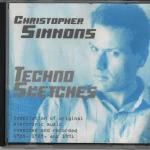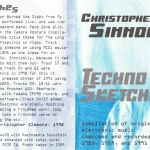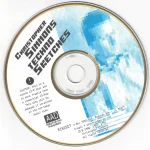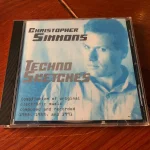“TECHNO SKETCHES” CD (1998) by CHRISTOPHER SIMMONS (CHRISTOPHER LAIRD SIMMONS)
“Techno Sketches” is a compilation of electronic instrumental music composed by Christopher Simmons in the era after he played in bands, and after his releases under the name, “Bluetoy.” These include various sketches composed using Steinberg PRO-24 sequencing software on the Atari 1040ST computer. The majority of the music had never been previously released commercially or used for film/video. The limited edition CD was released in 1998.
IMPORTANT NOTE: there were two versions of the CD, with slightly different track organization. This is the final sortation; however, liner note graphics scanned historically in 2022 from original physical copies may show different track references (e.g., track 4 became track 11, etc.) Original version had 17 tracks, final version had 18 with updated sortation.
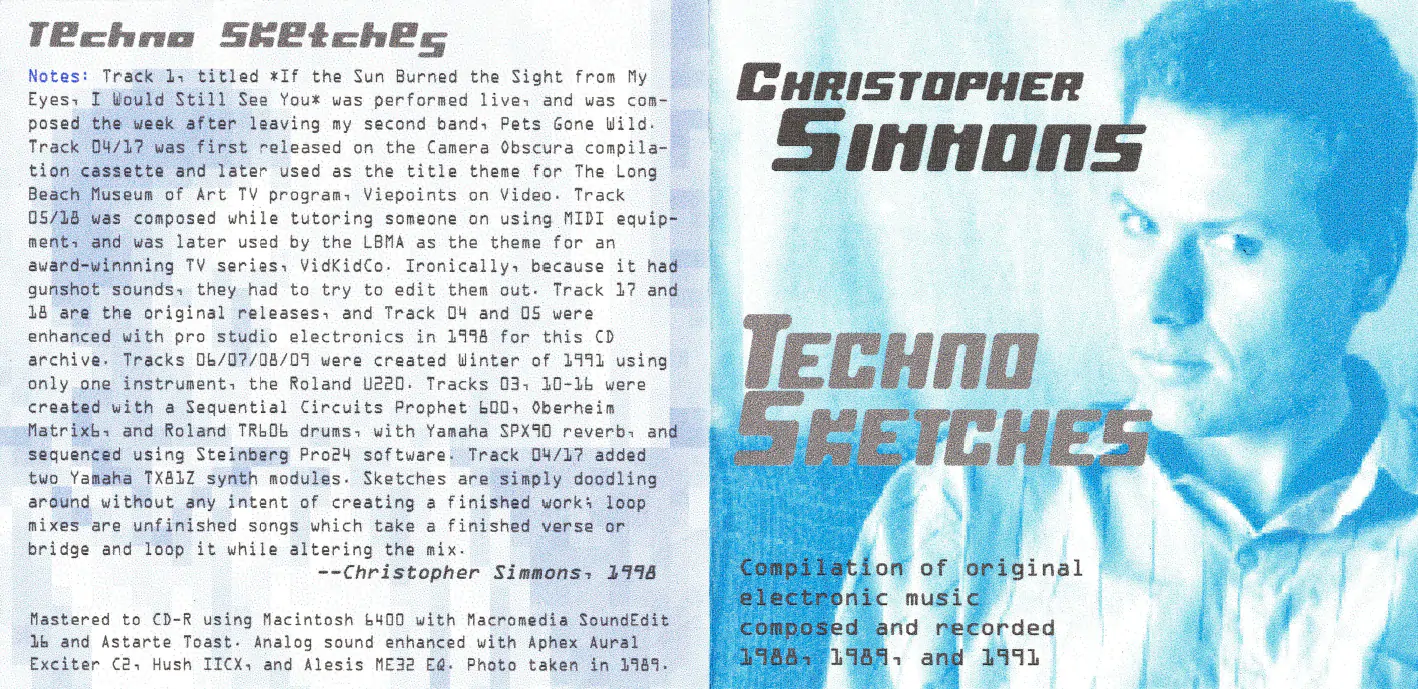
TRACKLIST:
01: If the Sun Burned the Sight from My Eyes, I Would Still See You
02: Sketch 02
03: Sketch 03
04: Sketch 04
05: Sketch 05
06: Sketch 06
07: Sketch 07
08: Sketch 08
09: Sketch 09
10: Sketch 10
11: Densitelemetry
12: Theme 89
13: Densitelemetry – 1998 Remaster
14: Theme 89 – 1998 Remaster
15: Sketch 1991 ONE
16: Memphis Funk 91
17: Sketch 1991 TWO
18: Sketch 1991 THREE
Technical note: as this CD was Christopher’s first attempt to create a commercial CD, and the software in the mid-late 90s for Mac was a bit crap, there are some ‘pops’ at end of silence on some tracks.
GALLERY:
(BETA)
NOTE: External links will be identified with icon and open in new browser tab.
GENERAL NOTES:
* All tracks recorded to Pioneer CT7R cassette deck using METAL tape.
* Tracks 3-10 were initial experiments learning to use the Steinberg Pro-24 MIDI sequencer circa 1987-88, running on the Atari 1040-ST. Never really intended for release and really first draft “sketches” and not polished works (as with many many of Simmons released works, ironically). 1987 onward tracks included the Yamaha TX81Z.
Anecdotal: MIDI timing was always a challenge with the Pro-24 software as it didn’t initially have the loose timing of an Akai MPC, which allows more of a human feel. Later on it did add more options for this.
* Tracks 15-18 were recorded Winter 1991 using Steinberg Pro-24 MIDI sequencing software on Atari 1040ST, using Oberheim XK MIDI keyboard controller, and single multi-timbral synthesizer, the Roland U220. During this period, Simmons had decided to return to music, sign up for USC film school and get back into music intending to do film soundtracks. Fate stepped in and he ended up getting engaged twice, then married the second one. Music took a many-year hiatus during this period to focus on family life.
TRACK NOTES:
Track 01: “If the Sun Burned the Sight from My Eyes, I Would Still See You.” performed live. Roland drum machine. Sequential Prophet 600 and Oberheim Matrix 6R, played on Oberheim XK controller. This also appeared on the “Camera Obscura Vol. 2” sampler cassette as “His Lover’s Daughter” (side 1, track 9).
Track 02: performed live using Oberheim Matrix 6R, played on Oberheim XK controller.
Track 03: This track started out as sort of a joke for Chris’ friend Jonas Sills. Chris and Jonas used to go to music stores together and look at the “unattainable” gear (e.g., Prophet 10, Yamaha DX5, CS80, etc.). Chris used to test keyboards playing this one little riff, which is the chorus here. Jonas kept saying, “Are you ever going to record that for anything?” This was a half-assed answer to that, composed on a Sunday morning using Steinberg Pro-24 on Atari 1040ST. Carvin 8-channel mixer. Way too much Yamaha SPX90II reverb.
Track 04: Experimental track composed using Steinberg Pro-24 on Atari 1040ST. Recorded with Prophet 600 and Matrix 6R, played on Oberheim XK controller. Yamaha SPX90II reverb, Carvin 8-channel mixer.
Track 05: Experimental track composed using Steinberg Pro-24 on Atari 1040ST. Recorded with Prophet 600 and Matrix 6R, played on Oberheim XK controller. Yamaha SPX90II reverb. Carvin 8-channel mixer.
Track 06: Experimental track composed using Steinberg Pro-24 on Atari 1040ST. Recorded using only the multi-timbral Oberheim Matrix 6R and using MIDI patch changes, played on Oberheim XK controller. Yamaha RX11 drum machine. Yamaha SPX90II reverb. Carvin 8-channel mixer. Chris’ Prophet 600 was in shop getting new keybed at this time (damn rubber bubble membrane technology!).
Track 07: Experimental track composed using Steinberg Pro-24 on Atari 1040ST. Recorded using only the multi-timbral Oberheim Matrix 6R and using MIDI patch changes, played on Oberheim XK controller. Yamaha RX11 drum machine. Yamaha SPX90II reverb. Carvin 8-channel mixer. Slightly more completed song than the earlier sketches.
Track 08: Experimental track composed using Steinberg Pro-24 on Atari 1040ST. Recorded using only the multi-timbral Oberheim Matrix 6R and using MIDI patch changes, played on Oberheim XK controller. Yamaha RX11 drum machine. Yamaha SPX90II reverb. Carvin 8-channel mixer. Probably the closest throwback to Simmons first couple of cassette release styles.
Track 09: Experimental track from 1987, adding the Yamaha TX-81Z to the Oberheim Matrix 6R, used for classic FM bass here. Yamaha RX11 drum machine. Yamaha SPX90II reverb. Carvin 8-channel mixer. Back to Chris’ “funky” stylings. 🙂
Track 10: Experimental track from 1987, composed using Steinberg Pro-24 on Atari 1040ST. Yamaha TX-81Z, Oberheim Matrix 6R, Yamaha RX11 drum machine. Yamaha SPX90II reverb. Carvin 8-channel mixer.
Track 11: “Densitelemetry” – the final 1987 era work; using Prophet 600, Oberheim Matrix 6R, Oberheim XK MIDI controller, Yamaha TX-81Z, Yamaha RX11 drum machine. Yamaha SPX90II reverb and Carvin 8-channel mixer. Recorded using the Steinberg Pro-24 MIDI software on Atari 1040ST. This track appeared on the “Camera Obscura” volume 2 sampler cassette (side 1; track 1).
Track was selected for the opening/closing theme for “VIEWPOINTS ON VIDEO” a one-hour video TV series airing in California across 14 cable systems. Episode #17 is the first to include the theme. Simmons’ name appears in the credits on screen. The show is produced by Martha Chono-Helsley, Joe Leonardi and Michael Nash; executive producer is the Long Beach Museum of Art. Series is sponsored in part by the National Endowment for the Arts and the California Arts Council. “Viewpoints on Video” features video artist(s) profiles and video/experimental works in their entirety.
Track 12: “Theme 89” – in 1989 Chris started a side business training locals on how to use the fairly new Steinberg Pro-24 software. This track was a demo he created on client system showing how to use the software. None of the equipment used belonged to Simmons. This track was used by the Long Beach Museum of Art Video Annex, as intro/outro theme for VIDKIDCO “Video Voices” TV/cable series. Ironically they tried to mask the gunshot sound (a popular sample on Yamaha drum machines of the era) since it was a kid-produced show! Track was originally titled “Funky Town USA with a Bullet.”
Track 13: “Densitelemetry” – 1998 “soft” remaster for this CD, using Aphex Aural Exciter, HUSHIICX and Alesis ME32 EQ.
Track 14: “Theme 89” – 1998 “soft” remaster for this CD, using Aphex Aural Exciter, HUSHIICX and Alesis ME32 EQ.
Track 15: First of series of tracks done Winter of 1991 using only the Roland U220 synthesizer, with the Oberheim XK MIDI keyboard controller. Also notable for the later enhanced timing options in Steinberg Pro-24 allowing for more humanistic recording of MIDI data when compared to the 1988-89 tracks. This was from a series of tracks intended to be a new EP but never released until the 1998 “Techno Sketches” album. First draft mix. Chris bought the U220 after going to the NAMM show and seeing Eric Persing demo it live.
Track 16: “Memphis Funk 91” – this track was built to demo a custom patch Chris created on the Roland U220 by using multiple “voices” from the horn patch to create a more vibrant “horn section,” and then playing on the Oberheim XK MIDI keyboard controller, which had an assignable slider which could be set to send breath controller data, and add more realistic “rises” while playing.
Track 17: A sketch track trying to see how far the U220 synth could be pushed in number of sounds, effects and patch switching. This track is also somewhat in the style of his early early work from 1984/85.
Track 18: This demo track falls into the style Chris had done many times of a simple piano piece with chords and little follow along melody.
Copr. ℗ © 1988, 1990, 1991, 1998, 2022 Christopher Laird Simmons – all rights reserved.

